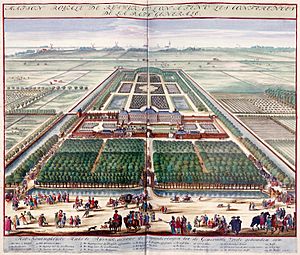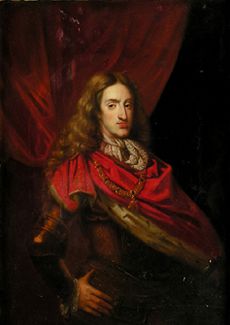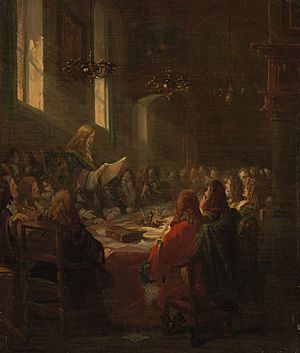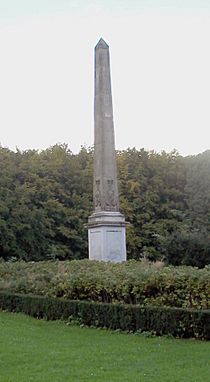Peace of Ryswick facts for kids
|
|
|---|---|

Huis ter Nieuwburg, location for the negotiations
|
|
| Context | End of the 1689–1697 Nine Years War; King William's War |
| Signed | 20 September 1697 |
| Location | Rijswijk |
| Negotiators | |
| Signatories | |
| Parties | |
| Language | French |
The Peace of Ryswick (also spelled Rijswijk) was a group of important agreements signed in the Dutch city of Rijswijk. These agreements were made between September 20 and October 30, 1697. They officially ended the Nine Years' War, which lasted from 1688 to 1697. This war was fought between France and a group of countries called the Grand Alliance. The Grand Alliance included the Dutch Republic and the Holy Roman Empire.
The Nine Years' War was one of many wars fought by King Louis XIV of France. During this war, neither side gained much land. By 1695, the war was costing a huge amount of money. There was also a lot of hunger and economic problems. Because of this, both sides really needed peace.
Negotiations for peace were slow. A big reason for the delay was the question of who would become the next ruler of the Spanish Empire. The current king, Charles II of Spain, had no children and was very sick. The closest people who could inherit his throne were King Louis XIV of France and Emperor Leopold I of the Holy Roman Empire. King Louis XIV did not want to talk about this issue. Emperor Leopold I refused to sign a peace treaty without it being discussed. He finally signed with great hesitation on October 30, 1697. Many people saw the Peace of Ryswick as only a temporary stop to the fighting. When King Charles II died in 1700, it led to another big war called the War of the Spanish Succession.
In Europe and North America, the peace agreements mostly put things back to how they were before the war. However, Spain did agree that France could control the island of Tortuga and the western part of Hispaniola (which became Saint-Domingue). In Europe, France gave back several areas it had taken since the 1679 Treaty of Nijmegen. These included Freiburg, Breisach, and the Duchy of Lorraine. But France was allowed to keep Strasbourg.
Contents
Why the War Ended

The Nine Years' War was very expensive for all the countries involved. Armies grew much larger during this time. In 1648, an average army had about 25,000 soldiers. By 1697, armies had over 100,000 soldiers. This was too much for countries before modern industry. For example, the war used up 80% of England's government money. Having so many men fighting also hurt the economy.
The 1690s were also a very cold time in Europe. This period is sometimes called the "Little Ice Age". Cold and wet weather caused harvests to fail in many parts of Europe in 1695, 1696, 1698, and 1699. In some areas, like Scotland, a large part of the population (5–15%) died from hunger.
Even though most fighting stopped in Europe after 1695, a smaller conflict continued in the Americas. This was known as King William's War. In early 1697, a French fleet arrived in the Caribbean. It threatened Spanish ships carrying treasure and English lands in the West Indies. England had taken the French colony of Acadia. Meanwhile, the French fought off attacks on Quebec. They also captured York Factory and caused a lot of damage to the economy of the New England area.
How Peace Talks Happened
The peace talks mostly focused on the "Spanish inheritance." This was the biggest political issue in Europe for 30 years. By 1696, it was clear that King Charles II would die without children. The main people who could take over his huge Spanish Empire were King Louis XIV of France and Emperor Leopold I. The Spanish Empire was a massive collection of lands around the world. It included Spain, parts of Italy, the Spanish Netherlands, the Philippines, and much of the Americas. If either France or Austria gained these lands, it would greatly change the balance of power in Europe.
King Louis XIV knew he wasn't strong enough to force his own choice for the Spanish throne. So, he tried to stop this topic from being discussed. He wanted to break up the Grand Alliance and make Emperor Leopold I stand alone. In 1696, Louis made a separate peace agreement with the Duchy of Savoy (called the Treaty of Turin). Louis also agreed to give the Duchy of Luxemburg back to Spain. This area was much larger than modern-day Luxembourg and was important for Dutch safety. Louis also agreed to recognize William III as the true king of England and Scotland. This meant he would no longer support James II, who had been exiled.
Official discussions between the different countries' representatives took place at the Huis ter Nieuwburg in Ryswick. A Swedish diplomat named Baron Lilliënrot helped guide the talks. Many parts of the Holy Roman Empire, like Baden and Bavaria, sent people to the talks. However, they were not directly part of the final treaties.
The talks were very slow. Emperor Leopold I often avoided making decisions until he absolutely had to. Since the agreements didn't solve the Spanish inheritance problem, he would only agree to a temporary stop to fighting. One of the Spanish negotiators, Bernardo de Quiros, ignored orders from Madrid to make peace at any cost. He supported Leopold's demand. Even though the British first wanted to keep fighting, King William became eager to finish the peace talks. William and Louis chose the Earl of Portland and Marshal Louis-François de Boufflers as their personal representatives. They met privately near Brussels in June 1697. They quickly agreed on the terms, and de Quiros's objections were ignored.
The peace was made up of several separate agreements. On September 20, 1697, France signed peace treaties with Spain and England. It also signed a ceasefire with the Holy Roman Empire. On September 21, France signed a peace and trade treaty with the Dutch Republic. When King Charles II became very ill, Leopold used it as an excuse to delay signing. One frustrated negotiator said it would be "shorter to knock (Charles) on the head, rather than all Europe be kept in suspense." The Spanish king got better. King William then threatened to end the Alliance if Leopold did not sign before November 1. Leopold finally signed on October 30.
The Treaties Signed
| Treaties of Ryswick and related treaties | |||||
|---|---|---|---|---|---|
| Date (New Style / (Old Style)) | Treaty name | Anti-French side | French side | Texts | |
| 29 August 1696 | Peace Treaty of Turin | Savoy | France | English (p. 196–208) | |
| 20 September 1697 (10 September 1697) | Peace Treaty of Ryswick | Habsburg Spain | France | English (p. 151–172) | |
| 20 September 1697 (10 September 1697) | Peace Treaty of Ryswick | England & Scotland | France | English (p. 127–138), Spanish (p. 8–15) | |
| 20 September 1697 (10 September 1697) | Peace Treaty of Ryswick | Dutch Republic | France | English (p. 214–226), French | |
| 30 October 1697 (20 October 1697) | Peace Treaty of Ryswick | Holy Roman Empire | France | English (p. 247–284), German, Spanish (p. 21–41) | |
What the Treaties Decided
The treaties mostly brought things back to how they were after the 1679 Treaty of Nijmegen. France was allowed to keep Strasbourg, which was a very important city for controlling Alsace-Lorraine. However, France had to give back other lands it had taken since 1679. These included Freiburg, Breisach, Philippsburg, and the Duchy of Lorraine to the Holy Roman Empire. France also had to leave Catalonia, Luxembourg, Mons, and Kortrijk in the Spanish Netherlands. The Dutch were allowed to place their soldiers in forts in Namur and Ypres. King Louis XIV officially recognized William as the king of England. He also stopped supporting the Jacobites, who wanted to put James II back on the English throne. Louis also gave up his claims to the Electorate of Cologne and the Electoral Palatinate.
In North America, things went back to how they were before the war. France got Nova Scotia back. However, small fights continued in the border areas. In the Caribbean, Spain recognized that France controlled the island of Tortuga and the western part of Hispaniola. France had actually set up its colony of Saint-Domingue there years before. Meanwhile, the Dutch gave back their colony of Pondichéry in India.
What Happened Next
Most countries saw the Peace of Ryswick as a temporary break in fighting. They expected the conflict to start again when King Charles II died. The war showed that France could no longer achieve its goals without allies. So, King Louis XIV tried two things. He started a diplomatic effort to find new allies. He also kept the French Army ready for war. The power of the Habsburg family grew after their victory in the Great Turkish War. However, some states like Bavaria became more independent. They started looking to Louis for support instead of Leopold.
The war used up a lot of money and resources from both the Dutch and French navies. Even though the Dutch still controlled trade in the Far East, Ryswick was a turning point. It marked the beginning of England's rise as a major global sea power. England had focused on trade in the Levant (Middle East). But now, its merchants started challenging Spanish and Portuguese control in the Americas. The French struggled to compete there. The huge debts the Dutch built up weakened their economy. London took over from Amsterdam as the main business center of Europe. The Nine Years' War, along with the 1701–1714 War of the Spanish Succession, marked the end of the Dutch Golden Age.
At the same time, the Tory party in the English Parliament wanted to cut costs. By 1699, the English army was reduced to less than 7,000 soldiers. This made it harder for King William to negotiate equally with France. Even though he deeply mistrusted Louis, William worked with him. They tried to find a peaceful solution for who would inherit the Spanish throne. These agreements, called the Partition Treaties, were signed in The Hague (1698) and London (1700). However, they ultimately failed to stop the war from breaking out again in 1702.
Sources
- Treaty of Ryswick, English translation
See also
 In Spanish: Tratado de Rijswijk para niños
In Spanish: Tratado de Rijswijk para niños




